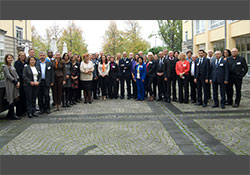Preventing, planning for and responding to floods: 24 Member States share experiences

WHO
In the WHO European Region, floods are the most common natural emergency, causing extensive damage and disruption. Over the last 20 years flood events have occurred in 49 of the 53 countries in the Region. Estimates for the Region, based on data from the International disaster database (EM-DAT) indicate that approximately 400 floods have killed more than 2000 people, affected 8.7 million and caused at least €72 billion in losses in the period 2000–2014.
On 19 and 20 October 2015, WHO/Europe organized a meeting on "Prevention, preparedness and response to reduce or avoid health effects of flood events", in Bonn, Germany. The meeting was attended by 24 Member States, representatives from the European Commission, the United Nations Office for Disaster Risk Reduction (UNISDR), and the Intergovernmental Panel on Climate Change.
Recent national and local experiences were discussed, as well as how best plan for the next flood event. A discussion document and a series of information sheets were prepared by WHO and shared with participants at the meeting.
Challenges in responding to floods
Common problems reported by Member States in planning and responding to flooding events include: coordination among stakeholders, risk communication, the management of safe water, sanitation, chemical pollution, evacuations, treatment of the injured and ill, continuity of treatment of chronic diseases, infectious disease outbreaks, reproductive health, dead bodies, and the psychosocial consequences of floods, and supporting vulnerable groups (chronic illness, migrants, pregnant women).
Participants agreed that planning for flood events is essential to avoid or reduce the effects on health. Other key conclusions were that risk management for flood-related health emergencies is best organized around the four priorities of the Sendai Framework for disaster risk reduction, and that further capacity building is needed to incorporate the International Health Regulations (IHR) 2005 into flood risk management.
Public health tools to prepare and respond to floods
Several tools were illustrated by WHO and others, such as the Emergency Response Framework, Hospital Safety Index, a toolkit for assessing health systems capacity in crisis management, geographic based risk assessment, the International Health Regulations, and the Interagency Standing Committee Cluster System. The European Union Decision 1082/2013/EU on serious cross-border threats to health enhances a coordinated EU response, strengthens preparedness and response planning, and enhances early warning and surveillance systems during cross-border events such as floods. This decision provides essential tools to disseminate flood health information and simulation exercises organized by the European Commission, which could be shared beyond EU borders.



